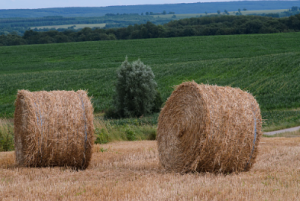There are several types of silage wrap. Silage wrap is a rolled, paper tube filled with wood or straw that holds plant materials in place while drying. The material used to make silage wraps varies, including cottonwood, jute, sisal, and coconut husks. The open-sided silage wrap is more common and less expensive than the closed-top silage wrap. It also allows the silage to soak up moisture and drain well.
 These are used to wrap bales of silage. Silacord, EconoFlex 5, and Suntight net replacement film are examples of some of the types of silage wrap available. In this article, we will discuss how to select one for your needs. Read on to learn about the pros and cons of each type of wrap. We will also discuss why some types are better than others.
These are used to wrap bales of silage. Silacord, EconoFlex 5, and Suntight net replacement film are examples of some of the types of silage wrap available. In this article, we will discuss how to select one for your needs. Read on to learn about the pros and cons of each type of wrap. We will also discuss why some types are better than others.
Silacord
Designed for optimum performance, Silacord is a five-layer co-extruded film with excellent tear resistance. Its high anti-UV content prevents film degradation and prevents spoiling fodder. It is suitable for both round and square bale wrapping, and its superior tear resistance makes it the perfect choice for large-scale bale wrapping. Furthermore, it is compatible with all kinds of wrapping machines.
It comes in sizes ranging from 30 inches wide to 5000 feet long. Silacord silage wrap is available from local stores at a competitive price and is suitable for a wide range of hay bale sizes. For additional information, call Silacord’s Forage Advice Line on 089 919808.
The wrap is available in different widths and lengths, which can be customized according to the bale’s shape and size. It offers exceptional air and water-tightness. It also sticks to bales immediately after wrapping, so there are no tails to worry about. High-performance wrapping machines can easily accommodate silage wrappers with three or more layers. If your bales are large, you can buy four layers of Silacord.
Ambraco
Ambraco silage wrap is an excellent way to protect your bales from weather and oxygen. Made of multiple layers, the film adheres to the round bale to form an airtight seal. As a result, it reduces heat buildup within the bales. It is ideal for use during the baling season, when the temperature may vary significantly. Unlike plastic wrap, the film is durable and can be used repeatedly.
The 7-layer Eco Plus silage wrap is the most durable film available today. Its superior mechanical properties and improved oxygen barrier make it a superior choice over the standard film. It also provides 33% more film per roll. Available in green, black and white, Ambraco silage wrap is manufactured from the latest polyethylene co-polymers. It provides excellent protection against punctures and impacts. Ambraco silage wrap can be used on round and square bales and has an excellent price/value ratio.
EconoFlex 5
The next-generation EconoFlex 5 silage film provides outstanding tear resistance and puncture resistance. Its excellent cling properties help to create airtight bales. Its versatility and consistency in performance across climates make it an excellent choice for most silage producers. Here are three reasons to choose EconoFlex 5:
Its design prevents dry matter from forming on bales. The folds of the film trap moisture, which then falls onto the fresh layer of soil underneath. It prevents pockets and depressions in the soil and decomposition of the bale. EconoFlex 5 silage wrap increases crop yields. Plus, it’s eco-friendly. It is easy to use, and it saves you money!
Suntight net replacement film
The invention relates to a replacement film for silage bales, specifically the production of bales from cut grass. Silage is traditionally produced by placing wilted cut grass in a pit. In recent years, however, it has been more commonly produced by wrapping the cut grass in plastic film. A round bale is first formed and then wrapped in at least two layers of plastic material film. Usually, this film is 25 microns thick and applied under tension.

 Polybase is an excellent choice for high-quality, reliable
Polybase is an excellent choice for high-quality, reliable